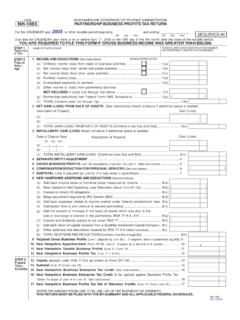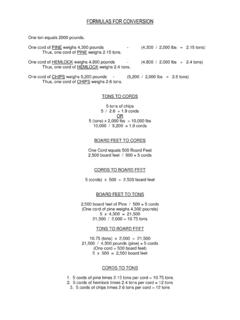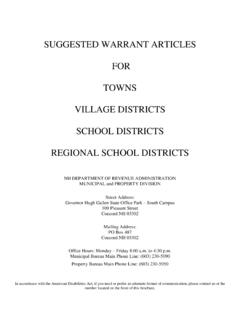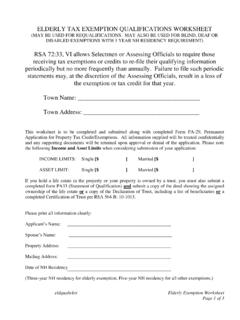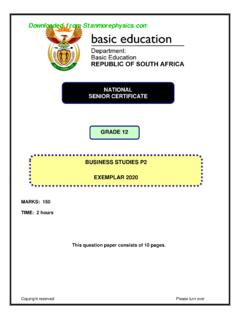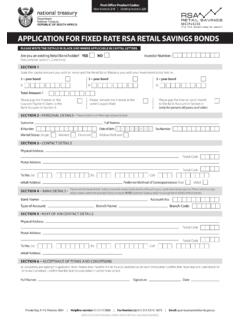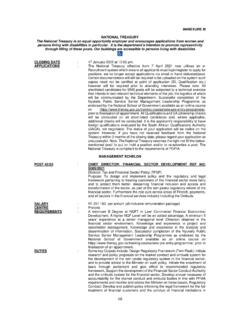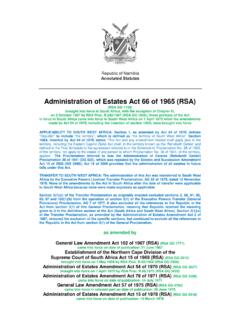Transcription of INSTRUCTIONS - New Hampshire
1 2020 CORPORATE. BUSINESS PROFITS.. NH-1120 TAX RETURN. INSTRUCTIONS . WHO MUST FILE. All business organizations, including single member Limited Liability Companies (SMLLC), taxed as a corporation federally must file a Form NH-1120 return provided they have conducted business activity in New Hampshire and their gross business income from everywhere is in excess of $50,000. "Gross business income" means all income for federal income tax purposes from whatever source derived in the conduct of business activity, including but not limited to gross proceeds from sales, compensation for rendering services, gross proceeds realized from trading in stocks, bonds, or other evidences of indebtedness, gross proceeds realized from sale of assets used in trade or business, interest, discount, gross rents, royalties, fees, commissions, dividends, without any deduction on account of the cost of property sold, the cost of materials used, labor costs, interest, discount.
2 Delivery costs, taxes, or any other expense paid or accrued and without any deduction on account of losses. NAME AND TAXPAYER IDENTIFICATION NUMBER-Page 1. CONFIDENTIAL INFORMATION. Tax information disclosed to the New Hampshire Department of Revenue Administration is held in strict confidence by law. The information may be disclosed to the United States Internal Revenue Service, agencies responsible for the administration of taxes in other states in accordance with compacts for the exchange of information, and as otherwise authorized by RSA 21-J:14. TAXPAYER IDENTIFICATION. The Commissioner of the Department of Revenue is authorized pursuant to RSA21:J27-a to require submission of an SSN, FEIN, or any other identifying number used in filing or preparing federal tax documents.
3 If you do not have any such identifying number, or share one with another taxpayer, then, under Code of Admin. Rules, Rev , you must obtain a Department Identification Number (DIN). If you have a DIN, use it on all New Hampshire filings. To ensure that your filings and payments are applied to the correct account, the sequence of names and taxpayer ID numbers on all filings must be consistent. The failure to provide a taxpayer identification number may result in the rejection of filed documents. Failure to timely file documents complete with a consistent taxpayer identification number may result in the imposition of penalties and interest, the disallowance of claimed exemptions, exclusions, credits, deductions, or an adjustment that may result in increased tax liability.
4 Enter the taxpayer's name and taxpayer identification number in the spaces provided. Enter the beginning and ending dates of the taxable period. These INSTRUCTIONS apply to a separate entity corporate filer. New Hampshire requires business organizations that are conducting a unitary business inside and outside New Hampshire to file a combined Business Profits Tax (BPT). return (a member of the unitary group must be subject to tax in another jurisdiction). Combined groups are required to file Form may obtain the form from our website at or by calling the Forms Line at (603)230-5001. IF THIS BUSINESS FILES A FORM 1120S U.
5 S. INCOME TAX RETURN FOR AN S-CORPORATION WITH THE INTERNAL REVENUE SERVICE, A NH DP-120. COMPUTATION OF S-CORPORATION GROSS BUSINESS PROFITS MUST BE COMPLETED BEFORE THIS FORM IS COMPLETED. CALCULATE YOUR TAX-Page 1 and 2. The Business Profits Tax is a tax assessed on taxable business profits. Round every entry to the nearest whole dollar (if 49 cents or less round down, if 50 cents or more round up). REPORT NEGATIVE AMOUNTS USING A MINUS SIGN. Line 1 Enter the amount from Line 28 of the Federal Form 1120 or complete a New Hampshire Form DP-120 (if applicable) and enter the amount from Line 2 of the Form DP-120 (Attach the completed Form DP-120 to the tax return).
6 Lines 2(a) through 2(g) are adjustments necessary to increase or decrease gross business profits to reflect the applicable Internal Revenue Code (IRC) applicable pursuant to RSA 77-A:1, XX and RSA 77-A:3-b. If a taxpayer seeks to report a necessary adjustment that has not been specifically addressed the taxpayer shall enter the item on either Line 2(d) or 2(f) and complete the attached Schedule IV. Pursuant to RSA 77-A:1, XX, New Hampshire has adopted the IRC as of a particular date for each taxable period. As a result, taxpayers must identify any changes to the IRC. occurring subsequent to the version adopted by New Hampshire , and account for those changes on their return.
7 Taxpayers must also make additional adjustments as directed by RSA 77-A:3-b. Applicable Internal Revenue Code Taxable Period Beginning IRC Version in Effect 01/01/2020 - Current December 31, 2018. 01/01/2018 - 12/31/2019 December 31, 2016. 01/01/2017 - 12/31/2017 December 31, 2015. 01/02/2000 - 12/31/2016 December 31, 2000. For prior taxable periods reference RSA 77-A:1, XX. NH-1120 INSTRUCTIONS 2020. Rev 10/2020 Page 1 of 4.. 2020 CORPORATE. BUSINESS PROFITS.. NH-1120 TAX RETURN. INSTRUCTIONS - continued The adjustments on lines 2(a) through 2(g) reflect the adjustments that are necessary to account for the version of the IRC adopted by New Hampshire .
8 If a taxpayer seeks to report a necessary adjustment that has not been specifically addressed, the taxpayer shall enter the item on either line 2(d) or 2(f). The statutory requirement to follow the IRC applicable pursuant to RSA 77-A:1, XX and RSA 77-A:3-b has significant impact on the tax basis of assets used in businesses operating within and without New Hampshire . A separate accounting of the New Hampshire tax basis must be maintained for depreciation purposes and for determination of the gain or loss in the event of the sale of business assets. LINE 2(a) Add the amount of IRC 179 expense taken on the Federal Return in excess of the amount permitted pursuant to RSA 77-A:3-b.
9 For property placed in service on or after January 1, 2017, the maximum IRC 179 deduction is $100,000. For property placed in service on or after January 1, 2018, the maximum IRC 179 deduction is $500,000. LINE 2(b) Add the amount of bonus depreciation taken on the Federal Return for assets placed in service this period. Bonus depreciation, allowed federally under IRC. 168(k), is not allowed for New Hampshire BPT purposes pursuant to RSA 77-A:1, XX and RSA 77-A:3-b. LINE 2(c) Add the amount of Domestic Production Activities deduction taken on the federal return this year. Domestic Production Activities deductions are not allowed on the NH-BPT return as allowed on federal returns per IRC 199.
10 This line does not apply to a Federal Form 1120S, Income Tax Return for an S Corporation as this deduction is taken on the shareholder return and no on the Form 1120S. LINE 2(d) Add any other deductions or exclusions taken on the Federal Return that need to be eliminated or adjusted due to revisions to the IRC occurring subsequent to the applicable version in the table above. Include foreign dividends, when actually distributed, that consist of amounts previously taxed federally as GILTI under IRC. 951A, or of amounts previously taxed federally as deemed one-time repatriation under the Tax Cuts and Jobs Act of 2017, but not previously subject to Business Profits Tax.

